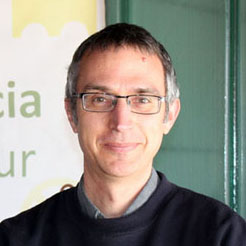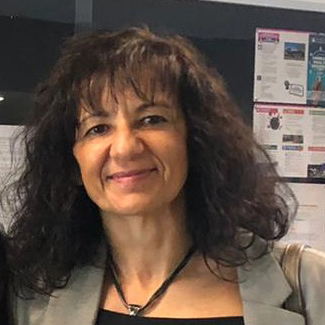M1. Introduction to the Master on Molecular Nanoscience and Nanotechnology: Basic concepts (6 ECTS)
Content: Basics concepts of chemical terminology in molecular systems, quantum mechanics and computational chemistry, statistical thermodynamics, solid state physics and materials science.




































M2. Fundamentals in nanoscience (4,5 ECTS)
Content: Top-down and bottom-up approach to nanoscience. Low-dimensionality concept and size-dependent phenomena. Fundamentals in nanophysics: nanomechanics, nanomagnetism, nanotransporte and nano-optics. Nanomaterials and nanostructures: main kinds of systems and general preparation methods of nanoparticles and thin films (chemical vapor deposition (CVD), physical vapor deposition (PVD), liquid phase deposition: spin coating, layer-by-layer, Langmuir Blodgett etc.)








M3. Physical characterization techniques (4,5 ECTS)
Content: Microscopy and spectroscopy techniques for characterizing nanostructures: resolution and typology of the information obtained; applications to molecular systems. Optical microscopies: confocal microscopy; NSOM microscopy (near-field scanning optical microscopy). Electronic microscopies: SEM (scanning electron microscopy) and TEM (transmission electron microscopy). Proximity microscopies. STM (scanning tunnelling microscopy). Surface study and atoms and molecular manipulation. Atomic Force Microscopy (AFM): basic principles; measurement modes; elastic local properties measurement; application of AFM to nanobiotechnology: biomolecules, tissues and membranes images; other proximity microscopies: lateral force microscopy, magnetic force microscopy, electrostatics force microscopy. Spectroscopic techniques: photon spectroscopies, X-ray spectroscopy, electronic spectroscopy. Characterization and analysis techniques of surfaces: high energy electronic diffraction (RHEED) and low energy electronic diffraction (LEED); surface electronic spectroscopies: X-ray photoelectron (XPS) and Auger (AES) spectroscopy; surface mass spectrometries.








M4. Physical nanofabrication techniques (3 ECTS)
Content: Optical lithography and electron beam litography. Fundamentals and limits; types of the resins used; pattern design and dimension measurements. Nanomanufacture by ion beams. Nanolithography by nanoprinting and microcontact: fundamentals, types of templates and printings. Methods based on proximity microscopy: local oxidation method and other nanolithographies based on AFM; molecules nanomanipulation; nanomanufacture and nanomanipulation based on STM and SNOM.




M5. Basic concepts of supramolecular chemistry (3 ECTS)
Content: Basic concepts in supramolecular chemistry: non-covalent interactions nature; ion, molecule and biomolecule recognition; molecular self-assembly and self-association: biological examples; kinetics and thermodynamics aspects; self-assembly by coordination bonds; hydrogen and other non-covalent bonds. Molecular topology: catenanes, rotaxanes and knots. Molecular devices: molecular diads and switches, logical doors, sensors. Signal amplification and antenna effect. Nanoparticle synthesis. Tensoactives: monolayers, micelles, vesicles and capsules.






M6. Molecular Nanomaterials: Preparation methods, properties and applications (6 ECTS)
Content: Molecular magnetic materials: design, synthesis, characterization and applications of i) magnetic nanoparticles obtained by molecular approach; ii) molecular nanomagnets (single-molecule magnets and single-chain magnets); iii) molecular magnetic multilayers; iv) bistable magnetic molecules. Materials with optical properties: liquid crystals, materials for non-lineal optics, optical limiters, etc.; supramolecular organizers typology and applications. Materials with electrical properties: molecular conductors and superconductors: electronic structures, organization on surfaces and on interfaces, properties and applications (chemical sensors, field effect transistors (FETs), etc). Carbon nanotubes: structures, properties, preparation and organization methods and applications.








M7. Use of supramolecular chemistry for the preparation of nanostructures and nanomaterials (3 ECTS)
Content: Hierarchical self-assembly and auto-organization: functional nanostructures and supra-molecular materials with interesting physical or chemical properties; design of bio-molecular architectures; design of functional molecules and nanomaterials with a high level of communication with biological systems and its biomedical applications. Organization of supra-molecular structures in surfaces: Self-assembled monolayers (SAMs). Use of self-assembled structures as templates for growing organic and inorganic nanostructures. Self-assembly of nanoparticles. Chirality in surfaces and its relevance in heterogeneous catalysis. Supramolecular polymers and block copolymers.








M8. Molecular electronics (4,5 ECTS)
Content: Introduction and basic concepts of the electronics based on molecular materials and the singlemolecule electronics. Charge transfer and transport in molecular materials and nanostructures. Supramolecular electronic devices: circuits, diodes, transistors, etc. Singlemolecule electronic devices. Molecular machines. Molecular materials for optoelectronic devices: photovoltaic cells, OLEDS, etc; Device structures and types; physical principles; constituent materials; comparison with inorganic devices. Molecule based detectors, sensors and actuators with chemical and biological interest; chemical sensors based on metallic oxides nanostructures. Materials processing techniques and molecular device preparation. Experimental and theoretical studies of charge transfer through molecules and molecular cables. Optical properties and electronic spectroscopy of sinlgemolecule systems. Experimental studies of the mechanisms for energy dissipation.








M9. Molecular nanomagnetism and spintronics (4,5 ECTS)
Content: Research in magnetic nanostructures and magnetic interfaces through the magnetic force microscopy (MFM) and the magnetic resonance force microscopy (MRFM). Magnetic domains study with spin polarized STM microscopy. Experimental detection of the magnetic moment in singlemolecule systems. Molecular spintronics.






M10. Current topics in molecular nanoscience and nanotechnology (6 ECTS)
Content: This course is integrated in the European School on Molecular Nanoscience (ESMolNa). This school intends to provide a suitable framework to show and extensively discuss the state-of-the-art in the molecular nanoscience and nanotechnology.
M11. Master dissertation (15 ECTS)
Content: Development of a research dissertation in this area.
Research lines associated with this Master are organised in five wide research fields:
Design of functional molecules and molecular-based nanostructures. Organization of molecules in surfaces and interfaces.
Molecular conductors and superconductors. Multifunctional molecular materials. Molecular photonic materials. Magnetic molecular materials. Switchable molecular materials. Porous coordination polymers (MOFs). Hybrid materials.
Preparation, study and theoretical modelling of optoelectronics materials, nanostructures and devices (solar cells, OLEDs, OFETs, molecular lasers…). Carbon nanostructures (fullerenes, carbon nanotubes, graphene, etc.) and its use in molecular electronics. Preparation, study and theoretical modelling of unimolecular electronic devices.
Preparation, study and theoretical modelling of molecular nanomagnets and molecular nanostructures. Molecules and materials for molecular spintronics. Magnetic molecules for quantum computing. Electronic and magnetic characterization of molecules and nanomaterials by proximity microscopy techniques (STM, AFM, MFM).
Applications of coordination chemistry in molecular magnetism and spintronics. Applications of coordination chemistry in molecular electronics. Biomedical applications of molecules and molecular nanomaterials. Molecular sensors. Molecular optoelectronic devices (solar cells, OLEDs, molecular lasers, etc.). Direct fuel production with solar light. Molecular spintronics devices (molecular spin-valves, spin-OLEDs, spin-OFETs, etc.).


